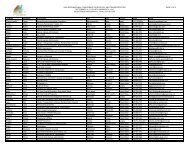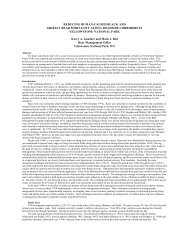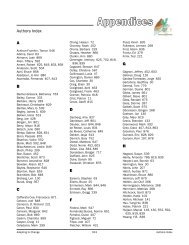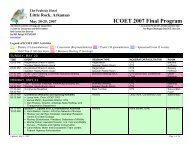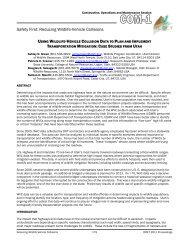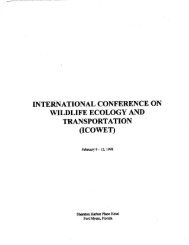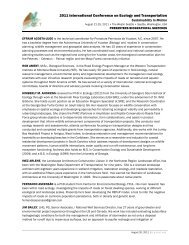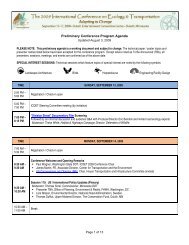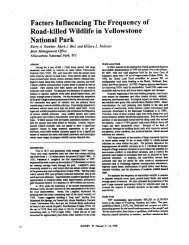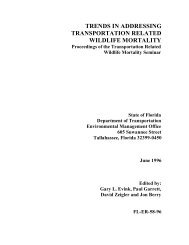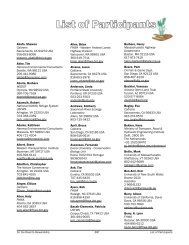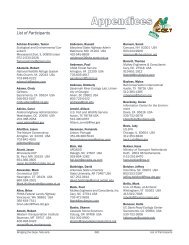Poster Sessions, pages 567-640 - ICOET
Poster Sessions, pages 567-640 - ICOET
Poster Sessions, pages 567-640 - ICOET
You also want an ePaper? Increase the reach of your titles
YUMPU automatically turns print PDFs into web optimized ePapers that Google loves.
Highway Median Impacts on Wildlife Movement and Mortality<br />
Angela Kociolek (406-994-6308, angela.kociolek@coe.montana.edu), Research Associate, Western<br />
Transportation Institute at Montana State University, Bozeman, MT 59717-4250 USA<br />
Anthony Clevenger (403-760-1371, tony.clevenger@pc.gc.ca), Research Ecologist, Western<br />
Transportation Institute at Montana State University, Harvie Heights, AB, T1W 2W2 Canada<br />
Abstract: Linear transportation features have been shown to have a barrier effect on certain wildlife species. In the<br />
case of highway median barriers or dividers designed for safety, little research has been done to gain an understanding<br />
of how these continuous linear structures affect the movement and mortality of different taxa. This research effort<br />
was comprised of a state of the practice survey, a literature review and gap analysis, and a qualitative assessment<br />
of potential wildlife impacts based on median barrier type and taxa size. Results from this cumulative effort have<br />
produced a foundation from which to develop rigorous field studies which should ultimately yield the basis for agency<br />
standards and guidelines. This study represents the first attempt ever in North America to synthesize information<br />
about highway median barriers and wildlife.<br />
Background and Purpose<br />
Transportation agencies (DOTs) regularly install solid concrete median barriers and, in some cases, incorporate mitigative<br />
designs without information on their effectiveness. Therefore a study of the interactions between vehicles, median<br />
barriers, and wildlife is needed. The continued use of concrete median barriers should be of concern where they bisect<br />
areas of ecological importance and wildlife populations. The aim of this Caltrans-sponsored project was to determine<br />
what is the current practice and knowledge in the US and Canada pertaining to potential impacts of highway median<br />
barriers on wildlife movement and mortality.<br />
Methods<br />
• The literature review focused on 1.) barrier effects of roads and linear infrastructure, 2.) historical and current<br />
trends of median barrier installation and unintended/potential impacts, and 3.) the effects of median barriers<br />
on a range of wildlife species and the performance of mitigative design solutions. The gap analysis culminated<br />
in a series of unanswered questions and limitations of available information.<br />
• Ninety-six biological/environmental and engineering specialists in DOTS in all 50 U.S. states and 13 provinces/territories<br />
in Canada were invited to participate in this online state of the practice survey. The survey<br />
addressed trends and patterns of installations, regulatory and practical issues in deployment, and agency-led<br />
research efforts to assess median barrier impacts on wildlife.<br />
• The qualitative assessment of potential wildlife impacts followed a matrix model whereby the potential permeability<br />
and mortality risks associated with common median barrier designs were assigned (based on intuitive<br />
and available information) for each taxa group of varying sizes.<br />
Summary of Findings<br />
Individually and collectively, these median barrier-wildlife research efforts confirm that a concerted study is needed in<br />
order to develop best practices for appropriate placement, design choice and mitigations to meet the needs of motorist<br />
safety while avoiding negative impacts to local wildlife populations.<br />
Literature Review and Gap Analysis<br />
The literature review substantiated median barriers have an effect on a wide range of wildlife from small to large. This<br />
statement largely comes from documented anecdotal data and intuitive public concern, however, there were some supporting<br />
scientific research studies. There is general agreement that barriers can result in increased wildlife mortality<br />
and decreased wildlife movements depending on the species and/or body size. Comprehensive studies that specifically<br />
measure these impacts are lacking. The absence of WVCs in some cases may be an indication that such barriers<br />
affect how, and if, wildlife move along and/or across roadways.<br />
State of the Practice Survey<br />
Thirty-four individuals representing 28 (or 45%) of DOTs in the U.S. and Canada completed the survey (figure 1).<br />
Results from the survey revealed there were few evaluations of median barriers impacts on wildlife.<br />
Bridging the Gaps, Naturally 609 <strong>Poster</strong>s



